Mornings in Bogotá meant ice cold showers in the cool mountain climate, mugs full of tinto (black coffee) or chocolate, and laughter and games at morning circle. Forty-seven participants had gathered from Australia, Brazil, Chile, Colombia, Guatemala, Peru, United States, Canada, El Salvador, Finland, México, and Thailand. Together they spent two weeks sharing experiences from different educational contexts all over the world, building new education tools, and filling the halls of our lodgings at Escuela Taller with music and dancing. The group consisted of teachers, principals, designers, engineers, social workers, students, researchers, artists, business owners, and physiologists all invested in the future of formal and informal education all over the globe. In the end, the participants worked in eight teams to develop creative classroom tools with six schools in the Bogotá area. Here’s a snapshot of what they made:
Playing, creating and learning together
at IDDS Educación
IDDS Educación
Lógico Matemático (Mathematic Logic)
The Lógico Matemático team created two prototypes: La Carrera de Dados y El Conejo Fru Fru. In la Carrera de Dados (Dice Race), teams of students solve simple math problems to advance along squares. El Conejo Fru Fru (Bunny Fru Fru) is a bunny with a see-through stomach that students can “feed” with play carrots after answering problems. It breaks up the routine of the class and gives students a common goal to work toward.
The Lógico Matemático team created two prototypes: La Carrera de Dados y El Conejo Fru Fru. In la Carrera de Dados (Dice Race), teams of students solve simple math problems to advance along squares. El Conejo Fru Fru (Bunny Fru Fru) is a bunny with a see-through stomach that students can “feed” with play carrots after answering problems. It breaks up the routine of the class and gives students a common goal to work toward.
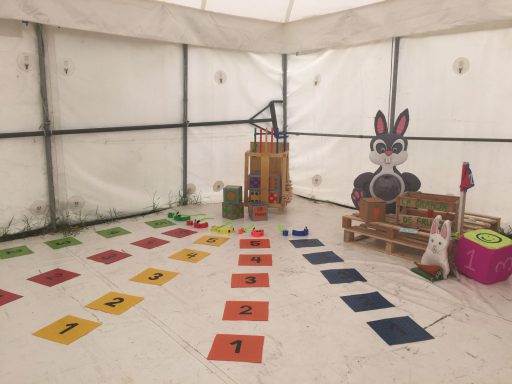
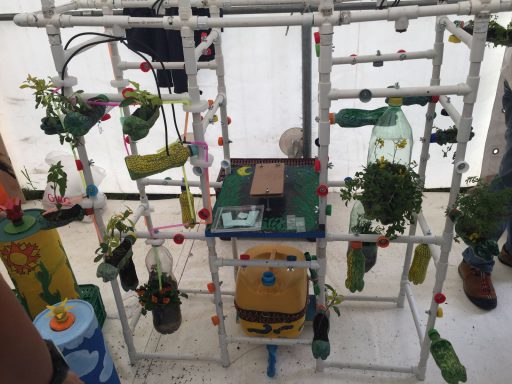
Semillero Huerta Vertical (Vertical Seedling Garden)
The Semillero-Huerta Vertical (Vertical Seedling Garden) is a modular vertical garden made from recycled materials including bottles, straws, and balloons. It contains a gravity-fed drip irrigation system. The nursery and irrigation system can be assembled entirely by the students and stored in the classroom. The garden helps them learn about the cultivation of seeds and plants, water systems, and facilitates group work.
The Semillero-Huerta Vertical (Vertical Seedling Garden) is a modular vertical garden made from recycled materials including bottles, straws, and balloons. It contains a gravity-fed drip irrigation system. The nursery and irrigation system can be assembled entirely by the students and stored in the classroom. The garden helps them learn about the cultivation of seeds and plants, water systems, and facilitates group work.
Centro de Innovación Desde la Didáctica (Teaching Innovation Center)
The Centro de Innovación Desde la Didáctica (Teaching Innovation Center) is a modular math-teaching object, created from panels that feature interactive math games. The mobile center focuses on cooperative, participatory learning in geometry and statistics. The center was created based off the desire from both teachers and students to create more interactive learning solutions that focused on group work and math that is applicable in real-life situations. The center is inclusive of different learning levels and requires no extra preparation from teachers.
The Centro de Innovación Desde la Didáctica (Teaching Innovation Center) is a modular math-teaching object, created from panels that feature interactive math games. The mobile center focuses on cooperative, participatory learning in geometry and statistics. The center was created based off the desire from both teachers and students to create more interactive learning solutions that focused on group work and math that is applicable in real-life situations. The center is inclusive of different learning levels and requires no extra preparation from teachers.
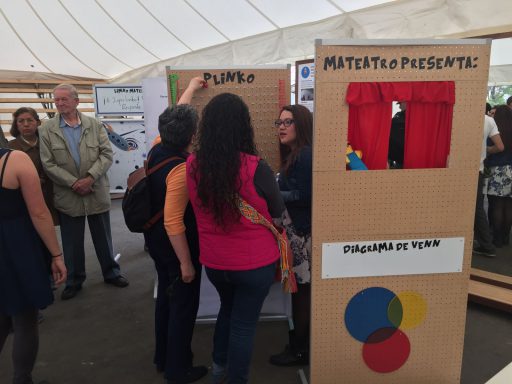
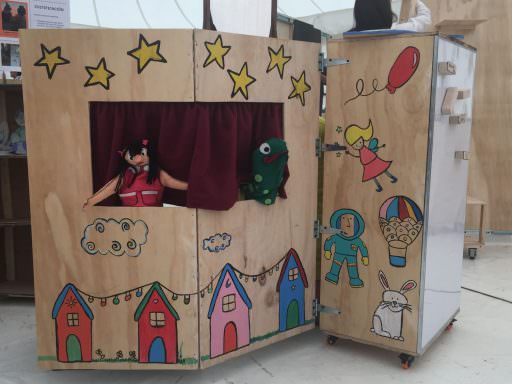
Comprensión Lectora (Reading Comprehension)
The Comprensión Lectora (Reading Comprehension) group created three prototypes: “Teatrin,” “¡Lea, Compa Lea!” and “Jenga Leo.” The Teatrin, a mobile library, contains storage space for books, puppets, pillows and games, in addition to functioning as a puppet theater. The back is a magnetic board for “Jenga Leo,” a game of magnetic blocks which students can use to create their own stories. ¡Lea, Compa Lea! is a reading comprehension game where students answer questions about the story and can also write their own questions for other students to answer. The project allows students to work on different aspects of reading comprehension: reading, writing, listening, and speaking.
The Comprensión Lectora (Reading Comprehension) group created three prototypes: “Teatrin,” “¡Lea, Compa Lea!” and “Jenga Leo.” The Teatrin, a mobile library, contains storage space for books, puppets, pillows and games, in addition to functioning as a puppet theater. The back is a magnetic board for “Jenga Leo,” a game of magnetic blocks which students can use to create their own stories. ¡Lea, Compa Lea! is a reading comprehension game where students answer questions about the story and can also write their own questions for other students to answer. The project allows students to work on different aspects of reading comprehension: reading, writing, listening, and speaking.
Artefáctor
Artefáctor is a compact, student-managed art space to promote the integration of all forms of art in education. As a station for both art creation and display, it is light, mobile, and flexible and can be used with theater, dance, art, and music classes. Artefáctor incorporations art storage, exposition space, and supplies. In schools with limited space, Artefáctor prominently displays art and creates a visible place for creation in a compact space.
Artefáctor is a compact, student-managed art space to promote the integration of all forms of art in education. As a station for both art creation and display, it is light, mobile, and flexible and can be used with theater, dance, art, and music classes. Artefáctor incorporations art storage, exposition space, and supplies. In schools with limited space, Artefáctor prominently displays art and creates a visible place for creation in a compact space.
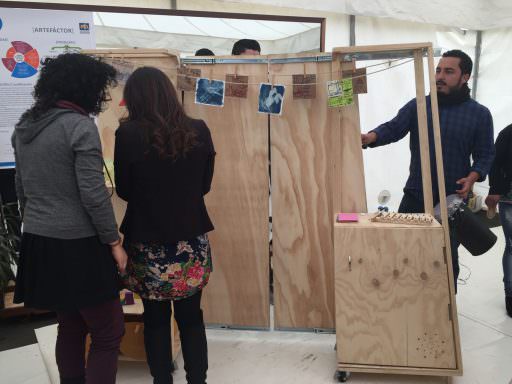
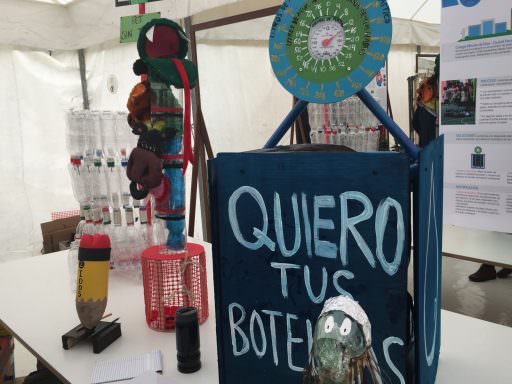
Colegio Basura Cero (Zero Waste School)
Colegio Basura Cero (Zero Waste School) consists of three separate prototypes: Caneca Educativa (educational wastebasket), Come Tapas (Top Eater), and Saca Puntas (Pencil Sharpener) The Caneca Educativa weighs the trash or recycled material and displays the weight on a scale that shows the environmental impact. Come Tapas is a monster created out of recycled bottles, which collects bottle caps. Saca Puntas creates a depository for pencil shavings, also made out of recycled bottles. All of the initiatives incentivize recycling at the school in a fun, interactive, and visible way.
Colegio Basura Cero (Zero Waste School) consists of three separate prototypes: Caneca Educativa (educational wastebasket), Come Tapas (Top Eater), and Saca Puntas (Pencil Sharpener) The Caneca Educativa weighs the trash or recycled material and displays the weight on a scale that shows the environmental impact. Come Tapas is a monster created out of recycled bottles, which collects bottle caps. Saca Puntas creates a depository for pencil shavings, also made out of recycled bottles. All of the initiatives incentivize recycling at the school in a fun, interactive, and visible way.
Centro Estudiantil Para el Desarrollo Creativo (Student Center for Creative Development)
Centro Estudiantil Para el Desarrollo Creativo (Student Center for Creative Development) is a student-managed space for collaboration and exploration. The students at the school want more space to develop their own ideas, explore different interests, and express themselves in different ways and this co-working space creates student-directed spaces and more interdisciplinary collaboration.
Centro Estudiantil Para el Desarrollo Creativo (Student Center for Creative Development) is a student-managed space for collaboration and exploration. The students at the school want more space to develop their own ideas, explore different interests, and express themselves in different ways and this co-working space creates student-directed spaces and more interdisciplinary collaboration.
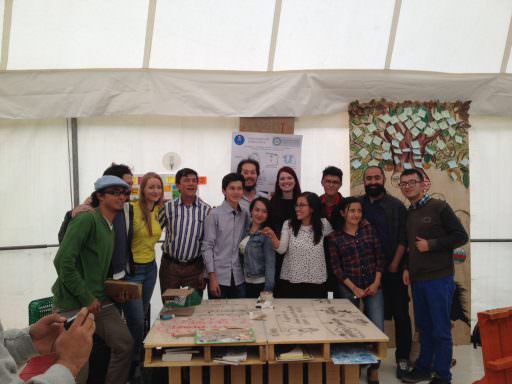
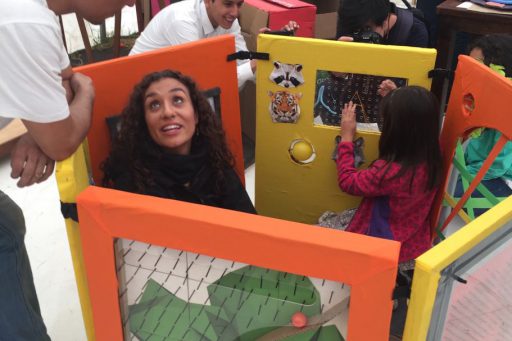
MuzúHitos
MuzúHitos is an interactive playpen for young children, created for a local mother’s group in Bogotá. The playpen consists of six different panels that form a hexagon. Each panel contains different games and textures for the child to interact that promote improved cognitive and fine motor skills. MuzúHitos addresses differences in developmental levels in young children, which create significant challenges in formal education.
MuzúHitos is an interactive playpen for young children, created for a local mother’s group in Bogotá. The playpen consists of six different panels that form a hexagon. Each panel contains different games and textures for the child to interact that promote improved cognitive and fine motor skills. MuzúHitos addresses differences in developmental levels in young children, which create significant challenges in formal education.
Este post fue publicado originalmente en este enlace de la página de la Red de Innovación para el Desarrollo Internacional, IDIN.